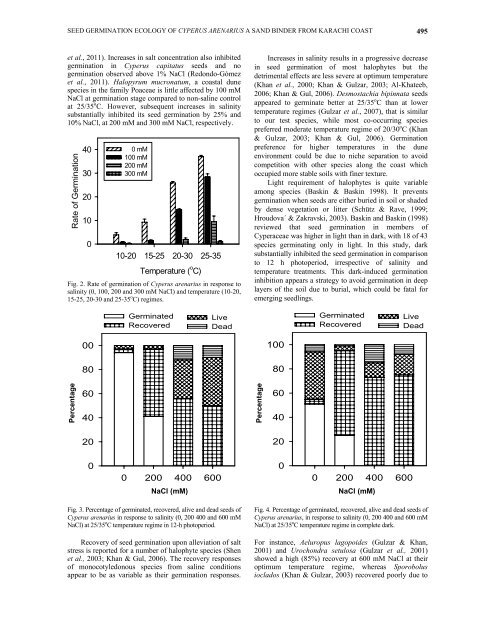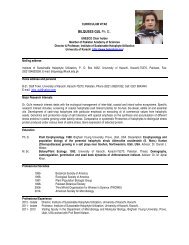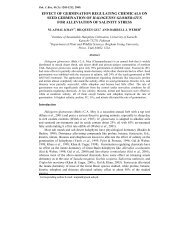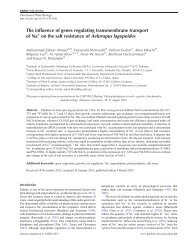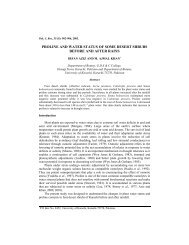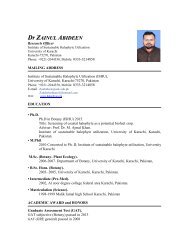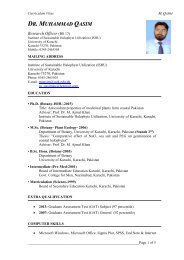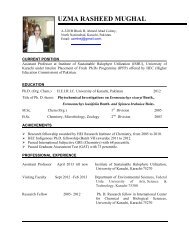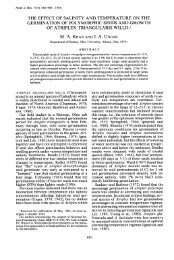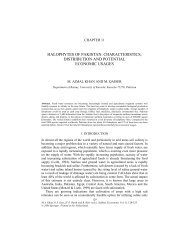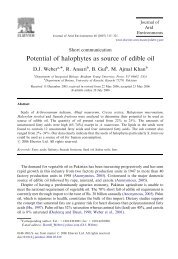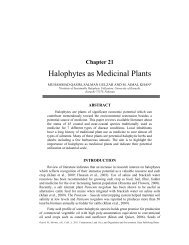seed germination ecology of cyperus arenarius â a ... - ResearchGate
seed germination ecology of cyperus arenarius â a ... - ResearchGate
seed germination ecology of cyperus arenarius â a ... - ResearchGate
Create successful ePaper yourself
Turn your PDF publications into a flip-book with our unique Google optimized e-Paper software.
SEED GERMINATION ECOLOGY OF CYPERUS ARENARIUS A SAND BINDER FROM KARACHI COAST 495<br />
et al., 2011). Increases in salt concentration also inhibited<br />
<strong>germination</strong> in Cyperus capitatus <strong>seed</strong>s and no<br />
<strong>germination</strong> observed above 1% NaCl (Redondo-Gómez<br />
et al., 2011). Halopyrum mucronatum, a coastal dune<br />
species in the family Poaceae is little affected by 100 mM<br />
NaCl at <strong>germination</strong> stage compared to non-saline control<br />
at 25/35 o C. However, subsequent increases in salinity<br />
substantially inhibited its <strong>seed</strong> <strong>germination</strong> by 25% and<br />
10% NaCl, at 200 mM and 300 mM NaCl, respectively.<br />
Rate <strong>of</strong> Germination<br />
40 0 mM<br />
100 mM<br />
200 mM<br />
300 mM<br />
30<br />
20<br />
10<br />
0<br />
10-20 15-25 20-30 25-35<br />
Temperature ( o C)<br />
Fig. 2. Rate <strong>of</strong> <strong>germination</strong> <strong>of</strong> Cyperus <strong>arenarius</strong> in response to<br />
salinity (0, 100, 200 and 300 mM NaCl) and temperature (10-20,<br />
15-25, 20-30 and 25-35 o C) regimes.<br />
Increases in salinity results in a progressive decrease<br />
in <strong>seed</strong> <strong>germination</strong> <strong>of</strong> most halophytes but the<br />
detrimental effects are less severe at optimum temperature<br />
(Khan et al., 2000; Khan & Gulzar, 2003; Al-Khateeb,<br />
2006; Khan & Gul, 2006). Desmostachia bipinnata <strong>seed</strong>s<br />
appeared to germinate better at 25/35 o C than at lower<br />
temperature regimes (Gulzar et al., 2007), that is similar<br />
to our test species, while most co-occurring species<br />
preferred moderate temperature regime <strong>of</strong> 20/30 o C (Khan<br />
& Gulzar, 2003; Khan & Gul, 2006). Germination<br />
preference for higher temperatures in the dune<br />
environment could be due to niche separation to avoid<br />
competition with other species along the coast which<br />
occupied more stable soils with finer texture.<br />
Light requirement <strong>of</strong> halophytes is quite variable<br />
among species (Baskin & Baskin 1998). It prevents<br />
<strong>germination</strong> when <strong>seed</strong>s are either buried in soil or shaded<br />
by dense vegetation or litter (Schütz & Rave, 1999;<br />
Hroudova´ & Zakravski, 2003). Baskin and Baskin (1998)<br />
reviewed that <strong>seed</strong> <strong>germination</strong> in members <strong>of</strong><br />
Cyperaceae was higher in light than in dark, with 18 <strong>of</strong> 43<br />
species germinating only in light. In this study, dark<br />
substantially inhibited the <strong>seed</strong> <strong>germination</strong> in comparison<br />
to 12 h photoperiod, irrespective <strong>of</strong> salinity and<br />
temperature treatments. This dark-induced <strong>germination</strong><br />
inhibition appears a strategy to avoid <strong>germination</strong> in deep<br />
layers <strong>of</strong> the soil due to burial, which could be fatal for<br />
emerging <strong>seed</strong>lings.<br />
Germinated<br />
Recovered<br />
Live<br />
Dead<br />
Germinated<br />
Recovered<br />
Live<br />
Dead<br />
100<br />
100<br />
Percentage<br />
Percentage<br />
80<br />
60<br />
40<br />
Percentage<br />
80<br />
60<br />
40<br />
20<br />
20<br />
0<br />
0 200 400 600<br />
NaCl (mM)<br />
0<br />
0 200 400 600<br />
NaCl (mM)<br />
Fig. 3. Percentage <strong>of</strong> germinated, recovered, alive and dead <strong>seed</strong>s <strong>of</strong><br />
Cyperus <strong>arenarius</strong> in response to salinity (0, 200 400 and 600 mM<br />
NaCl) at 25/35 o C temperature regime in 12-h photoperiod.<br />
Recovery <strong>of</strong> <strong>seed</strong> <strong>germination</strong> upon alleviation <strong>of</strong> salt<br />
stress is reported for a number <strong>of</strong> halophyte species (Shen<br />
et al., 2003; Khan & Gul, 2006). The recovery responses<br />
<strong>of</strong> monocotyledonous species from saline conditions<br />
appear to be as variable as their <strong>germination</strong> responses.<br />
Fig. 4. Percentage <strong>of</strong> germinated, recovered, alive and dead <strong>seed</strong>s <strong>of</strong><br />
Cyperus <strong>arenarius</strong>, in response to salinity (0, 200 400 and 600 mM<br />
NaCl) at 25/35 o C temperature regime in complete dark.<br />
For instance, Aeluropus lagopoides (Gulzar & Khan,<br />
2001) and Urochondra setulosa (Gulzar et al., 2001)<br />
showed a high (85%) recovery at 600 mM NaCl at their<br />
optimum temperature regime, whereas Sporobolus<br />
ioclados (Khan & Gulzar, 2003) recovered poorly due to


